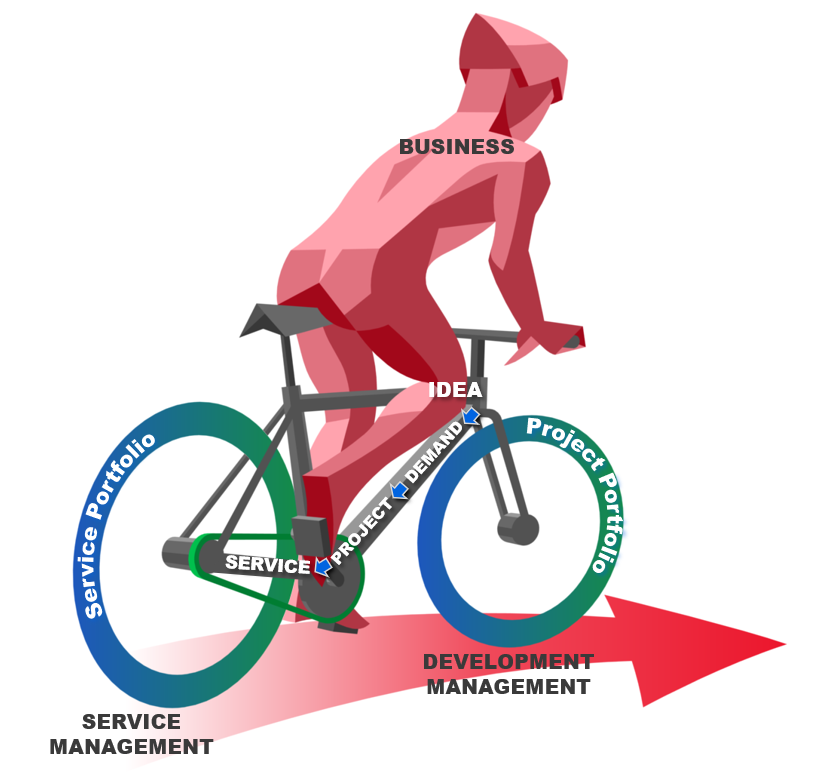“Le Tour de Service Lifecycle Management” – Like riding a bike!
Service development is much like… riding a bike! This article helps you as CIO, Service Owner or Project Manager to pedal in the right direction with fewer bumps and more energy.
Each day I meet various directors who all have the following demands:
“As CIO, I should be able to view all of my company’s portfolios and projects in one place and see where we are headed. Right now that information is spread across multiple tools.”
“In my role as a Service Owner I should be able to see into the future. But instead I am just putting out fires that keep suddenly igniting.”
Every company has processes, practices, and desktop or cloud-based tools to manage their projects. Why then does a lack of visibility seem to be such a major problem for the decision-makers I meet?
Sounds scarily familiar? The typical practices of service development
There are as many ways to organize a development management process as there are people organizing it. Processes vary in maturity, and the possible selection of tools for each stage is vast. However, nearly every project organization follows these same steps, at least from a wider perspective:
- Email is used to discuss ideas and demands, and the best ones are presented in steering groups.
- When a demand gets funded, it is turned into a Project and added to a Project Manager’s task list.
- Progress of the Project is followed via PowerPoint presentations, and deliverables are saved in “The Folder” specifically created for this project.
- A Service Manager agrees with the proposed go-live date and schedules trainings.
- The results of the Project come alive as a Service which is monitored for a couple of weeks to make sure everything works as planned.
Those IT organizations that follow standards and good manners have also set up “offices” to help with management: PMO’s and SMO’s. Project organizations often categorize their projects and other development tasks into project portfolios. Similarly, service management organizations structure their services and owners into service portfolios. To make things even more complicated, sometimes each stage of a product or service lifecycle has its own tools!
Like riding a bike! Service development made simple
Successful management of a product lifecycle requires frictionless cooperation between two integral units – much like the two wheels in a bicycle.

In the adjacent picture, the front wheel represents Development Management, which decides the direction of progress. The rear wheel represents Service Management, which makes progress possible. The Business is steering the course and pedaling speed for the rear wheel. The bike frame that connects the rear and front wheels is the development pipeline. The transparency of that pipeline depends on a company’s maturity to formulate raw ideas into usable services. All of these individual parts have to work in harmony so that the bicycle can move.
The executives I meet often complain about a lack of visibility. The underlying reason behind this problem is that their bike frame is broken. Without a functioning frame, Development Management and Service Management are like two separate unicycles, haphazardly trying to wobble along.
How to set your Service Development in fluid motion?
The first step in making sure your Service Development is truly effective is choosing the right frame for your bicycle. It is possible to follow the entire lifecycle of a project from the initial idea to the introduction (and eventual wind-down) by using modern platforms such as ServiceNow or Cloud Coach. The management can see who came up with ideas, plan the funding for each portfolio, direct the progress of projects, and follow up on the actualization of business benefits.
From an operative point of view, it is possible to see the downtime rate of a service, what changes are underway, how much it cost to build the service, and what its costs are. All the stages of a service lifecycle should be integrated into the same frame.
The next step is to select a matching pair of tires for your bike. This is easier if your project and service portfolios are synchronized. Your Service Manager will be able to see into the future when all projects are categorized based on services right from the beginning of their lifecycle.
A well-built frame and harmoniously spinning wheels will give your company a chance to stay ahead of your competitors. These two elements will also give you time to focus on developing services instead of waiting in terror for future fires that need putting out.
What type of bike will you be riding this summer?
The author Miika Rautio specializes in Development and Service Management. At Sofigate, he works on tools and processes to support Service Lifecycle Management.


